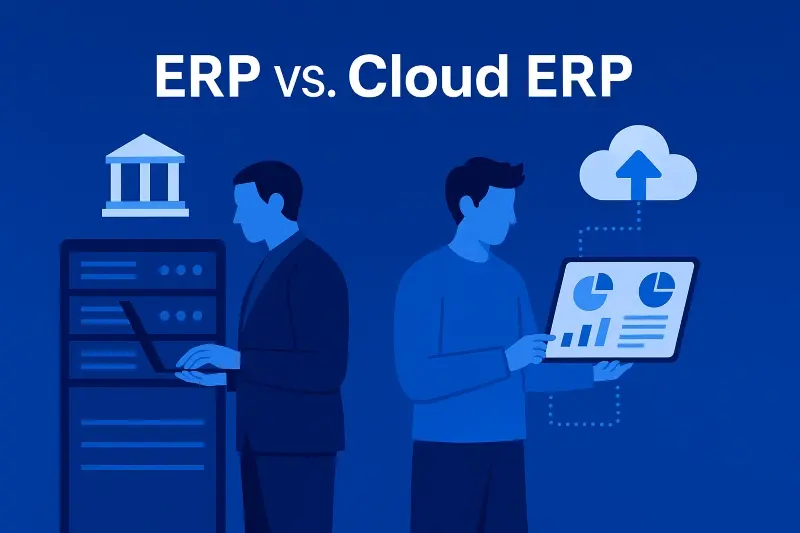ERP vs. Cloud ERP: The Old Way and the New Way Explained
Understanding ERP vs Cloud ERP Every business runs on processes like finance, supply chain, projects, payroll, and reporting. When those processes...
5 min read
The Milestone Team 1/30/19 10:49 AM

Table of Contents
Updated 9/24/25
Business buzzwords come and go. Phrases that once felt exciting quickly turn into background noise. Even ideas we now take seriously—like cloud computing, business intelligence, and digital transformation—were once brushed aside as temporary trends.
But time has a way of sorting what really matters. As we move toward 2026, finance digital transformation has proven to be much more than a passing fad.
It’s become a strategic must-have—a way for companies to run smarter, stay competitive, and create real value every single day.
Finance digital transformation means modernizing finance operations with integrated technology, real-time data, and automation. It’s more than swapping old software for new.
It’s a continuous change in how finance creates value, improves teamwork, and boosts efficiency.
Unified, trusted data
All financial systems connect so everyone works from the same accurate numbers—no silos or duplicate information.
Automation
Approvals, billing, reconciliations, and closing the books happen automatically, cutting manual entry and reducing errors.
Staff can focus on analysis and planning instead of repetitive tasks.
Real-time insight
Live financial data and predictive analytics support quick, confident decisions and early risk detection.
Secure mobility
Teams can access information safely from the office, home, or field, keeping work moving wherever they are.
In short, finance digital transformation replaces fragmented, manual processes with connected, automated, insight-driven finance.
It helps leaders adapt faster, set strategy with confidence, and deliver more value—without extra headcount or error-prone workflows.
It might seem natural to assume digital transformation starts with IT.
But finance is where the real change takes hold.
CFOs and finance leaders are uniquely positioned for this role because they:
Oversee budgets, reporting, and risk. No one understands where money is made or lost better than finance.
Spot inefficiencies first. Manual data entry, inconsistent project costs, and fragmented data management all hit the books long before they become visible elsewhere.
Connect every department. Finance interacts with sales, operations, projects, and inventory, making it the natural hub for organization-wide transformation.
By leading digital change, CFOs move from gatekeepers to growth drivers.
They shape the company’s digital transformation strategy, guide investments in modern technology, and ensure every decision is based on timely, accurate information.
A successful transformation strategy needs more than better spreadsheets—it needs a modern foundation for the entire business.
That foundation is a cloud-based system, often in the form of a flexible cloud ERP (Enterprise Resource Planning) platform.
Unlike older financial software that require VPN connections or nightly uploads, cloud ERP is accessible anywhere with a simple Wi-Fi connection.
It merges financial, project, and operational data into one real-time system, supporting both everyday finance operations and long-term digital transformation goals.
Key advantages include:
Real-time financial data and dashboards. Up-to-the-minute insight builds confidence in every decision.
Process automation. Approvals, billing, and expense tracking happen automatically, cutting errors and saving hours every month.
Scalability and flexibility. Add project accounting, inventory management, or CRM modules as the business grows—without rebuilding the system.
Lower IT workload. Automatic updates and built-in security reduce maintenance demands and compliance risks.
Integrated data management. APIs and open integrations ensure data flows freely across departments, creating a unified financial solution.
Better collaboration. With a single source of truth, every department—finance, operations, sales, and field teams—works with the same accurate data.
For finance teams, this means less time chasing numbers and more time using them.
For the entire organization, it means faster responses to market changes, fewer errors, and stronger profitability.
Digital transformation isn’t just a technology project.
It creates lasting advantages that touch every part of the business and keep paying dividends long after the initial rollout.
Real-time financial reporting becomes standard practice. Month-end closes that once dragged on for weeks can wrap up in days.
Automated approvals and billing shorten cash cycles and reduce costly errors.
Predictive analytics powered by artificial intelligence (AI) and machine learning (ML) highlight potential risks and allow early action.
Live job costing shows project costs as they happen—labor, materials, and unexpected changes—so teams can protect margins.
Forecasts are more reliable because everyone is working from the same real-time financial data.
Digital transformation uses modern technology and automation to meet changing business needs and keep pace with a fast-moving finance environment.
Automation of key finance functions—like financial close and reporting—removes bottlenecks and strengthens data accuracy.
Artificial intelligence and machine learning power personalized services, improve credit scoring, detect fraud, and automate complex workflows.
Predictive analytics gives early warnings on financial trends and supports smarter risk management.
Cloud computing enables instant analysis and reporting, ensuring that every decision is based on the most current information.
Because regulations and market conditions keep changing, modern digital technology helps companies adapt quickly and stay compliant.
Importantly, digital transformation in finance is a continuous journey, requiring long-term commitment to innovation, continuous learning, and adaptation, ensuring finance functions stay ready for new technologies and future digital needs.
APIs and seamless integrations eliminate data silos and double entry.
Self-service financial dashboards give department leaders instant access to the numbers that matter to them—without waiting on a report.
Built-in audit trails and automated controls help maintain compliance with changing regulations.
Modern security and role-based access reduce the risks tied to legacy systems and manual data entry.
These advantages free finance teams to spend less time chasing data and more time guiding strategy, supporting innovation, and driving profitability.
The financial landscape is evolving quickly, and digital transformation trends show how finance teams can keep pace.
Rise of AI and data analytics. Artificial intelligence and advanced data analytics are reshaping credit scoring, fraud detection, and predictive forecasting.
From automated reconciliation to dynamic dashboards, these solutions simplify and accelerate every part of the finance workflow.
Cloud-based financial systems. Organizations are adopting flexible, scalable cloud-based systems to manage complex data and meet changing regulations.
Continuous learning and adaptation. Digital transformation strategy is shifting from one-time projects to continuous learning and ongoing adaptation, ensuring that finance leaders can adopt new technologies as they emerge.
Deeper data management. The ability to handle vast amounts of real-time financial data supports more sophisticated reporting and long-range planning.
These trends show that digital transformation of finance is a continuous process—a commitment to constant improvement powered by modern technology and smart, connected systems.
Modernizing finance with digital technology doesn’t have to be overwhelming.
The most successful strategies begin with small, measurable steps, show clear value early, and expand at a steady pace.
Define clear goals. Decide which outcomes matter most—faster reporting, stronger cash flow, or better project visibility.
Capture early wins. Automating accounts payable or digitizing approvals builds confidence and proves immediate value.
Expand in phases. Start with core financials, then add project management, inventory, or CRM modules as each stage delivers measurable ROI.
This phased rollout keeps budgets predictable and minimizes risk, while demonstrating progress at every step.
The real impact of finance modernization is felt when it shifts from a one-time project to an everyday way of working across the business.
Here’s what that looks like:
Instant access to information—from a laptop in the office or a mobile device on a job site—means decisions can be made the moment they’re needed.
Data becomes action. CFOs and managers see financial trends forming and can adjust pricing, reallocate budgets, or pivot projects in real time.
Collaboration is seamless. Managers, supervisors, and finance staff use the same dashboards and speak the same language.
Innovation is continuous. AI-driven analytics and open APIs make it easy to connect new applications and roll out fresh ideas without rebuilding your tech stack.
Customer and partner confidence grows. Faster billing, clearer project updates, accurate financial forecasts, and an improved customer experience build trust and strengthen long-term relationships.
Instead of struggling with outdated tools and disjointed processes, the organization gains built-in agility.
Expanding into new markets, adding product lines, or responding to new regulations is no longer a technology hurdle—it’s simply part of the plan.
Finance digital transformation, when fully realized, is not just a one-time upgrade.
It’s a long-term strategy that leverages advanced, modern technology to help the business adapt quickly, scale confidently, and remain competitive year after year.
Finance modernization is essential in today’s digital business environment.
A successful digital transformation depends on advanced technology, new digital tools, and connected digital platforms that provide real-time data and intelligent automation.
Together, these capabilities streamline finance, assess risks early, and support confident decisions.
With the right strategy and a digital transformation ERP partner like Milestone IS, organizations can turn their digital transformation journey into everyday practice—building stronger processes, adopting new digital tools as they evolve, and improving efficiency while strengthening financial controls so they stay prepared for whatever comes next.

Understanding ERP vs Cloud ERP Every business runs on processes like finance, supply chain, projects, payroll, and reporting. When those processes...

The skyrocketing growth of the digital landscape has left cosmetics manufacturers rushing to keep up with evolving customer demand. Customers now...